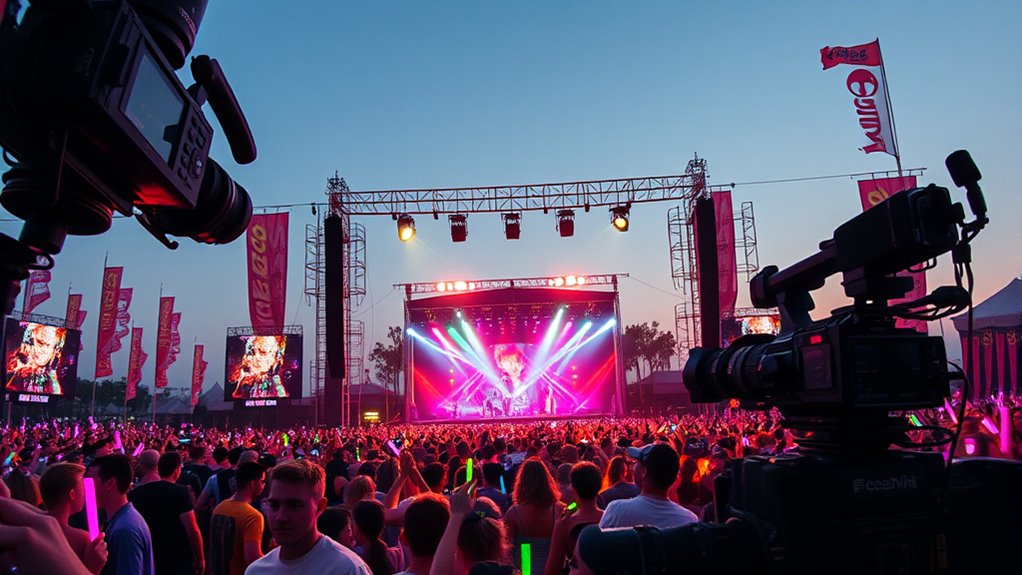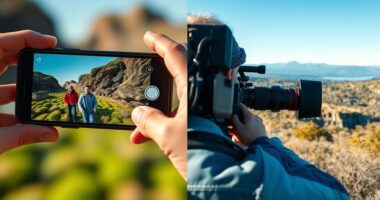To use festival footage in your music video legally, you need to secure sync licenses for both the visuals and the music. This involves obtaining permissions from rights holders like songwriters, publishers, and visual content owners. You’ll need to negotiate terms including usage scope, duration, and fees. Proper rights management guarantees you avoid legal issues and protects your creative work. Keep exploring to discover how to navigate these licensing steps effectively.
Key Takeaways
- Obtain rights for festival footage separately, ensuring proper licensing from rights holders before use.
- Secure music synchronization rights by negotiating with songwriters, publishers, and record labels involved.
- Clearly define the scope and usage terms—duration, territories, and formats—in licensing agreements.
- Understand and differentiate between visual content rights and music rights to avoid legal overlaps.
- Proper rights management safeguards your project from legal disputes and ensures confident sharing of the final video.

Ever wondered how your favorite TV show or commercial features the perfect song? The secret often lies in the complex process of sync licensing. When you’re planning to use festival footage in a music video, understanding how music clearance and licensing negotiations work is essential. These steps ensure you have the legal right to synchronize a song with your visual content, avoiding costly legal disputes down the line.
Music clearance is the first critical step. It involves obtaining the necessary permissions from rights holders—typically the songwriters, publishers, and record labels—to use a specific piece of music. Without proper clearance, your music video risks being taken down or facing legal action. To clear the music, you need to identify who owns the rights and negotiate terms for usage. This process can be time-consuming, especially if multiple rights holders are involved, but it’s non-negotiable if you want your project to be legally sound.
Once you’ve identified the rights holders, licensing negotiations come into play. This phase involves discussing the terms of use, including how long you can use the song, in what territories, and whether you’ll pay a flat fee or royalties based on views or sales. Negotiations can be straightforward if the song is not particularly popular or already licensed for multiple projects, but they can become complex with hit songs or exclusive rights. During these discussions, you might face pushback on certain terms, so being flexible and understanding the rights holders’ needs is key. Sometimes, rights holders may require you to credit them or include specific language in your video’s description.
It’s also important to note that licensing a song for a music video isn’t the same as licensing festival footage itself. You’ll need to secure rights for the visual content separately, especially if it’s footage you didn’t create yourself. Combining licensed music with festival footage adds layers of complexity, making it crucial to clearly define what’s covered in each license agreement. Additionally, understanding the importance of proper rights management can help prevent potential legal issues down the line.
Navigating music clearance and licensing negotiations might seem intimidating, but they’re essential steps that safeguard your project and ensure you don’t face legal repercussions. Taking the time to do it right pays off by giving you peace of mind and the ability to showcase your music video without worries. Remember, securing all necessary rights upfront is the best way to protect your creative work and focus on sharing your vision with your audience.
Frequently Asked Questions
Can I Use Festival Footage Without Obtaining Rights?
No, you can’t use festival footage without obtaining copyright permissions. Festival footage is typically protected by copyright, and using it without permission could lead to legal issues. You need to secure rights or licenses from the copyright holder before incorporating festival footage into your music video. Ignoring these rights risks copyright infringement, which can result in takedowns, fines, or legal action. Always prioritize getting proper permissions to avoid complications.
What Are the Costs Associated With Sync Licensing for Festival Footage?
Think of sync licensing costs as a balancing act between creative freedom and budget considerations. You can expect to pay a fee that varies based on factors like footage exclusivity, duration, and usage scope. Cost estimation can range from a few hundred to thousands of dollars. To avoid surprises, you should clearly define your budget and negotiate terms upfront, ensuring your project stays financially feasible while securing the rights you need.
How Long Does the Licensing Approval Process Typically Take?
The licensing approval process usually takes anywhere from a few weeks to a couple of months. Your timeline may face delays due to licensing complexities or negotiations with rights holders. To avoid unexpected setbacks, start the process early, communicate clearly, and stay flexible with your deadlines. Keep in mind, some licenses might require additional approvals, which can extend the timeline further. Being proactive helps ensure a smoother approval journey.
Are There Restrictions on How I Can Edit Festival Footage in My Video?
You have some editing flexibility with festival footage, but restrictions depend on your license terms. Generally, you can add visual effects or cut scenes, but avoid altering the core content that might misrepresent the event or breach licensing agreements. Always review your licensing terms carefully to understand specific restrictions, ensuring your edits stay within permitted boundaries while creatively enhancing your music video.
What Are the Penalties for Unauthorized Use of Festival Footage?
Did you know that copyright infringement cases can cost creators up to $150,000 per violation? If you use festival footage without proper licensing, you risk serious legal repercussions, including hefty fines and lawsuits for licensing violations. Courts take unauthorized use seriously, and you could face damages, injunctions, or even criminal charges. Always secure the necessary rights to avoid damaging legal consequences and protect your creative work from costly penalties.
Conclusion
Now that you understand the ins and outs of sync licensing for festival footage, you’re better equipped to bring your music videos to life. It’s funny how a simple license can turn a spontaneous festival shot into a mesmerizing story. When you align the right permissions, those unforgettable moments become yours to share. So, next time you’re filming, remember: the right license can make all the difference between a fleeting memory and a legendary music video.










